Every day is a lesson in building trust. My earliest memory of trust came when I was seven years old. I was riding my bicycle barefooted around the neighborhood when my toe got caught in the spokes. I remember lying on the ground, bloody and crying, then my dad came to scoop me up and take me home. He sat me down on the sink counter and consoled me as he fixed my toe.
He taught me there that trust is the unwavering belief we will have each other’s back.

Building trust happens in small, meaningful moments where we show up for each other, regardless of the past. Trust requires us to do whatever is necessary to protect the relationship with each other. That lesson has been the cornerstone for how I show up in relationships, coach executives, and lead teams.
Building trust at work or in your personal life requires the same actions. In this article, I’ll list the four core actions of building trust with teams. I’ll also share some practical ideas for earning trust back after it’s been lost.
This article is your ultimate guide to earning trust and keeping it!
WHY DOES BUILDING TRUST IN THE WORKPLACE MATTER?

Building trust in the workplace matters because trust is your most important competitive advantage. Without it, everything else suffers. You can get compliance from workers when trust is low because they need a paycheck to take care of their families. However, you will never gain their loyalty and discretionary effort. Countless studies have shown that as trust increases, so does overall performance.
- According to Gallup’s
research, 96% of engaged employees trust management compared to only 46% of
disengaged employees.
- An IBM study
titled Talent and Workforce Management discovered that about 37% of organizational
performance was driven by trust in senior leaders. Trust in senior leaders had
a positive effect both on cooperation and innovation in the workplace.
- According to a Golin-Harris poll, 53% of customers say they would stop buying from a company if they distrust its senior leadership.
Building trust matters in the workplace because it impacts leaders’ credibility, employees’ efforts, and customer loyalty. All of those factors affect the bottom line of every business.
BUILDING TRUST WITH EMPLOYEES REQUIRES 4 ACTIONS FROM LEADERS:

1 – COMMUNICATE WITH TRUTH
Truth is the ability to share your perspective.
Truth is a tricky word. We often assume our truth is a fact, and we become defensive when others don’t agree. Yet, truth is usually a matter of perspective. Our perspective changes all the time due to our life experiences, core values, people we surround ourselves with, and the information we choose to absorb daily.
“Raise your hand if there is someone on your team you should have a conversation with, but you’ve been putting it off?” A sea of hands goes up in the audience. This is the response I receive all the time when I am speaking across the country. When you dig deeper and ask managers why they’ve put off having these conversations, you hear the same responses:
- “I don’t want to deal with the drama.”
- “I avoid conflict.”
- “I’m not sure how to approach the conversation.”
- “I’m hoping it will go away.”
All relationships suffer when people hold back and stop telling their truth about what is going on.
All people can handle the truth. What they cannot handle are silence and secrecy. Great leaders love people enough to tell them the truth, and they also create space for others to share their truth.
Below are six actions to building trust with truth:
- Love people enough to tell them the truth
- Be consistent
- Support your truth with stories, data, statistics
- Take accountability
- Demonstrate a track record of results
- Build your knowledge
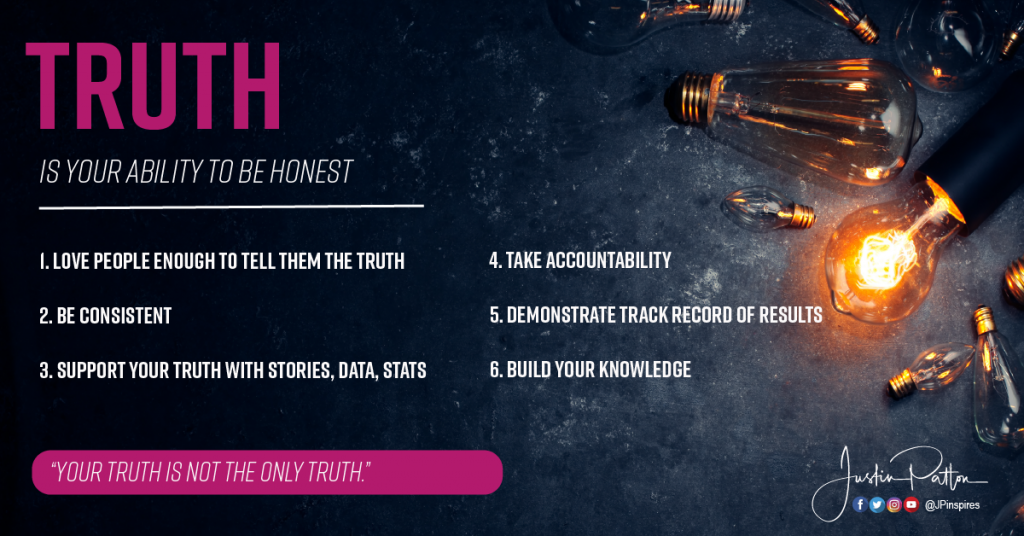
2 – COMMUNICATE WITH TRANSPARENCY
Transparency is your ability to explain the why behind your actions.
Remember as a kid when you would ask your parents to go somewhere and they said, “No.” Your next line was always, “Why not?” And then came the classic line that every parent has said more than they are willing to admit, “Because I said so!”
This line might work for parents who can lead out of authority and control. However, it will only serve to erode trust between leaders and employees. Employees need and deserve to understand the why behind decisions, requests, and company direction.
Brene Brown said, “When people don’t have all the information, they fill it in with fear.” Fear causes people to create stories based on zero facts, spread gossip, and waste a lot of energy trying to understand what is going on. Company culture and productivity always suffer as a result.
Below are six actions to building trust with transparency:
- Explain the why behind your decisions
- Share your intentions, feelings, and motivations
- Refuse to keep secrets
- Admit mistakes quickly
- Embrace vulnerability
- Make yourself available
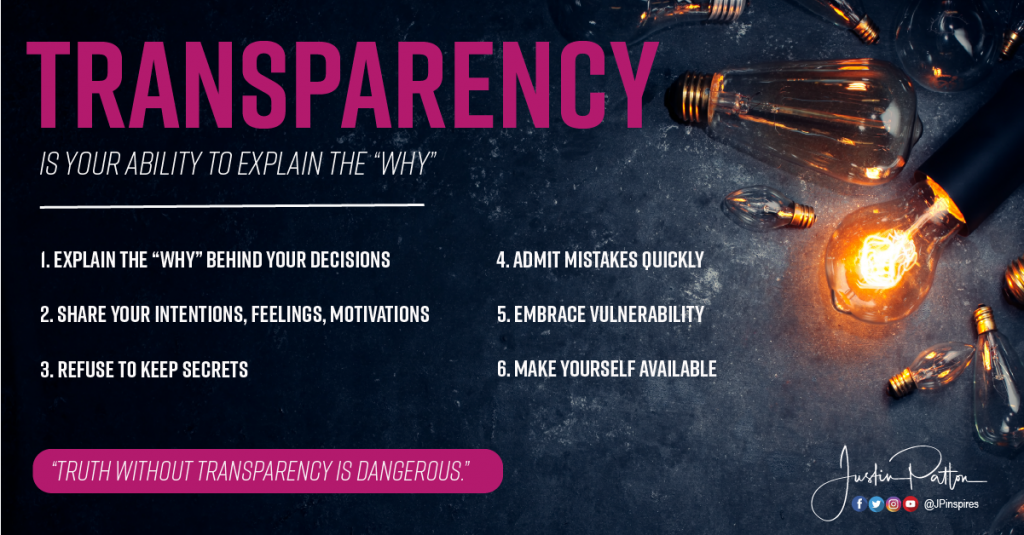
3 – COMMUNICATE WITH TACT
Tact is the ability to manage your intensity.
Communicating with tact means focusing as much on how you deliver your message as on what you say. Intensity needs to be managed and directed effectively to create and maintain trust in leadership.
I once had the opportunity to interview Melissa Lora, the former President of Taco Bell International. I asked what she thought was the single most significant factor that held leaders back in their careers. She said, “They let their intensity get in their way.”
She defined intensity as “being so focused on your agenda that you are unaware or uninterested in how your presence is impacting others on the team.” She explained that intensity intimidates people out of their best thinking, and it erodes trust.
You should always ask yourself, “Does my presence make it safe for people to tell me the truth?” We know from neuroscience that when people are emotionally triggered, the amygdala part of the brain takes over and sends them into fight or flight mode. Nobody shows up their best when that happens.
Below are six actions to building trust with tact:
- Manage your intensity
- Demonstrate approachable body language
- Pause before reacting
- Communicate without judgment and shame-dealing
- Listen with the intent to understand others
- Lead with respect and kindness
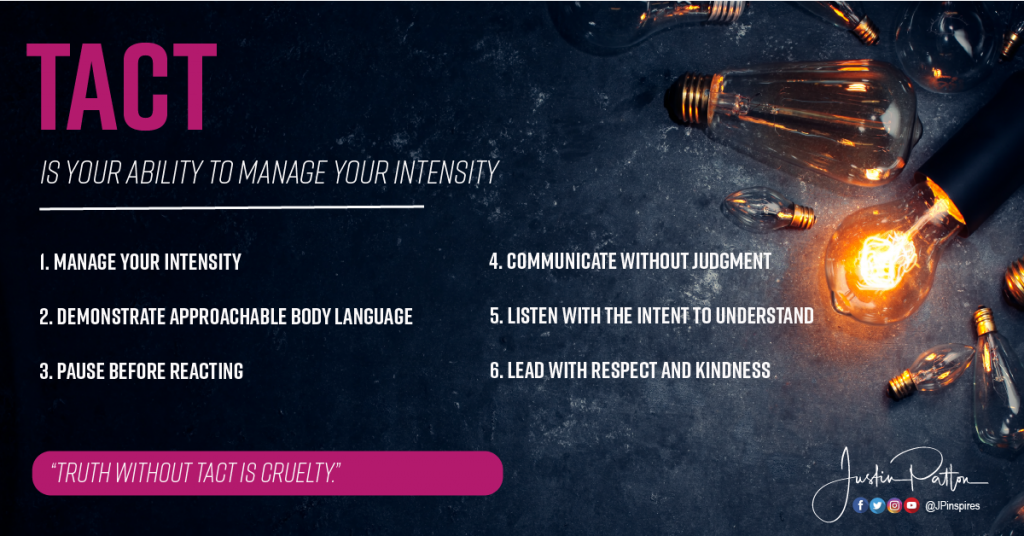
4 – COMMUNICATE WITH TOGETHERNESS
Togetherness is your ability to put the relationship before yourself.
I had a coach once tell me that there are three people in every relationship: you, the other person, and the relationship itself. There will be times you’re mad at the other person, but you must love “the relationship” enough to act in ways that build long-term, sustainable trust.
In over a decade of leadership and coaching experience, I’ve found that competence never held any of my clients back. Each problem they faced came down to relationships and how their actions eroded trust. It’s a lack of focus on togetherness that ultimately holds them back, not their competence.
I coached an executive leader at a Fortune 500 company. He was one of the brightest people I ever met. Yet, his problem was a constant focus on himself. He was always the first to speak in meetings. He gave a counter-argument to everyone else’s ideas, and he was quick to become defensive. As a result, he eroded trust among many of his peers. The question that helped him slowly start to change his behavior was, “What would you do differently if you focused on building trust in the relationship over your need to be right?”
Communicating with togetherness is letting go over your need to be right in the short-term moment. Togetherness is a commitment to play the long game.
Below are six actions to building trust with togetherness:
- Demonstrate empathy
- Honor boundaries
- Keep others’ confidence
- Ask for input and feedback
- Show genuine interest & concern
- Be inclusive
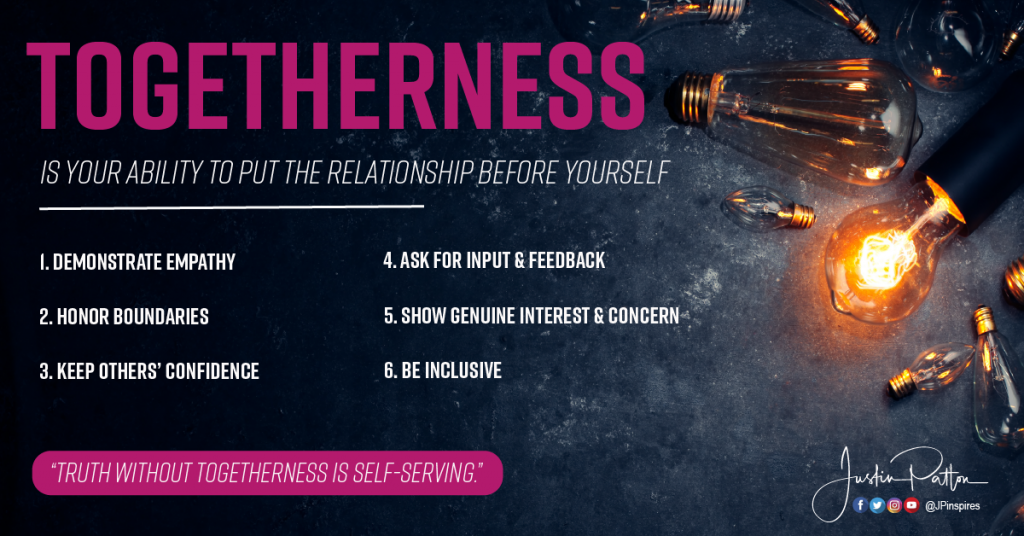
8 ACTIONS THAT ERODE TRUST IN LEADERS
“Trust triggers” are actions that erode trust. Most trust triggers between a leader and their team members are not deal-breakers. They do, however, cause a crack in the relationship. Leaders must have both the awareness and humility to address these cracks in the foundation. When they don’t, the crack continues to grow, and the relationship silently suffers.
All trust triggers are a result of ego. In my first leadership book, Bold New You, I define ego as “any fear-based thought that pulls you out of the truth of who you are.” Your ego causes you to act in ways that are incongruent to who you are at your best. Ego always has you put yourself before everyone else, and you cannot have trust when that happens. Leaders will make mistakes, but they must be intentional about acknowledging those mistakes and rebuilding the trust.
Below are 8 common trust triggers leaders make:
- Not telling the truth
- Sharing confidential information
- Not making yourself available
- Failing to listen and hear others
- Saying one thing while doing another
- Not recognizing people and their achievements
- Refusing to take accountability
- Putting profit before people
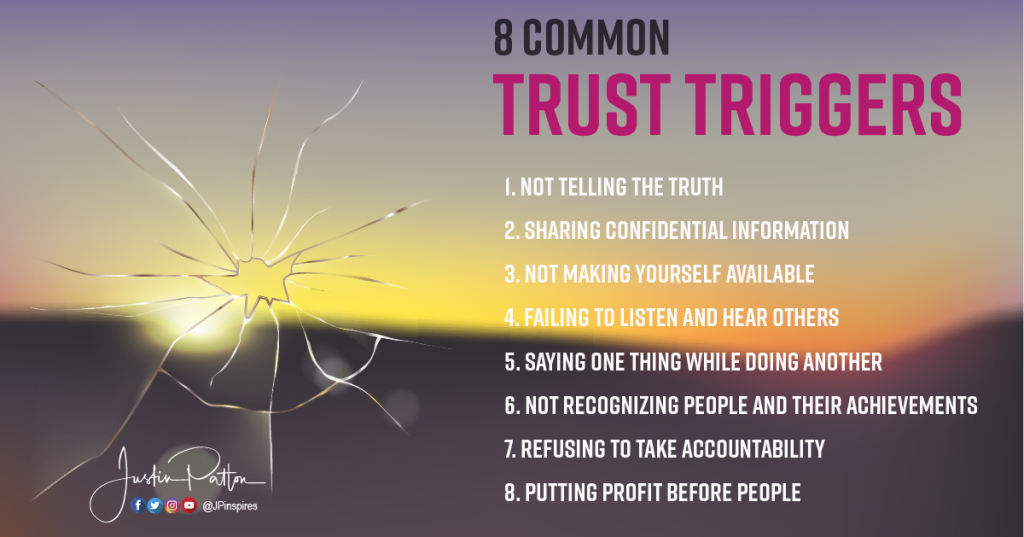
EARNING TRUST BACK AFTER IT HAS BEEN ERODED
All relationships are lessons in trust. Anyone who has ever been in a long-term relationship knows that you’re going to disappoint each other unintentionally. You’re human. You’re not always going to get it right. That’s true professionally – just as much as it is personally. You must be committed to earning trust back if you want healthy relationships and a company culture that employees never want to leave.
Use These Four Steps to Earn Trust Back:
STEP 1: TAKE FULL ACCOUNTABILITY FOR YOUR PART IN THE DYSFUNCTION
The first step to repairing any relationship where the trust is broken is taking full accountability for how you’ve contributed to the problem. Both people have a part to play. That doesn’t mean the parts are equal. Your job is to take full accountability for how you contributed to the dysfunction.
STEP 2: PRACTICE FORGIVENESS
The second step to repairing broken trust is extending forgiveness both to yourself and the other person. Forgiveness is not denying what happened, letting someone off the hook, or condoning the behavior. Forgiveness is your commitment to the future and the refusal to allow the past to keep you stuck there.
STEP 3: DEMONSTRATE A CHANGE IN BEHAVIOR
The third step in repairing a relationship where trust is broken is demonstrating a change in behavior. If you’re the individual that eroded trust in the relationship, then show up demonstrating your commitment to the relationship. You don’t have to play the constant victim to remind someone how sorry you are. The best apology is a change in behavior.
STEP 4: BE WILLING AND AVAILABLE TO TALK
The fourth step in repairing a relationship where the trust is broken is making yourself available to talk about the issue. One conversation is often not going to repair trust that is broken. More questions and emotions often come up after we’ve had time to think. Value the relationship enough to engage in these uncomfortable and sometimes repeated conversations.
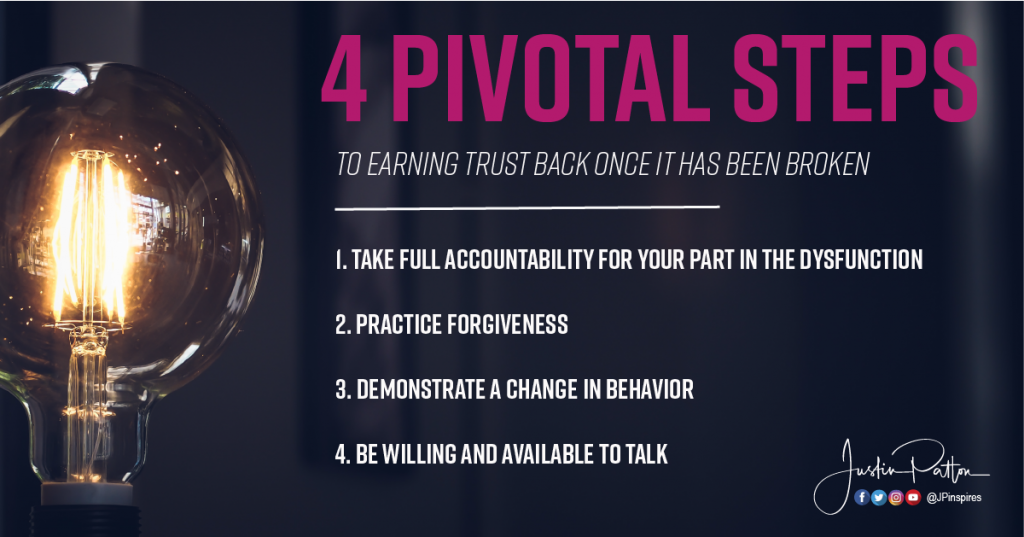
BUILDING TRUST IS NOT EASY, BUT IT’S WORTH IT
New York Governor, Andrew Cuomo, was widely recognized and applauded for his response to the coronavirus pandemic. He demonstrated what trust in action looks like. He managed to show up and stand out in a way that builds high levels of trust with his constituents. He did this by providing daily televised briefings where he was scrupulous with the truth. Second, he was transparent about why his administration made the decisions they made. His transparency created clarity and certainty. Third, he communicated with tact. His approach was both one of confidence and humility. He pushed back when necessary but never let his intensity overshadow his message. He demonstrated deep empathy for front-line responders and for the people that lost their lives to their virus. Finally, his messages were always focused on the theme of togetherness and doing what was best for the community. His leadership presence has become a model on how we expect leaders to lead in a crisis.
Building trust in teams is not easy. It takes intentionality, vulnerability, and a long-term commitment. The best leaders, who produce the best results and workplace culture, consistently lead and communicate with truth, transparency, tact, and togetherness.
Which one of these four trust factors do you need to put more focus on this week?
Have questions about leadership presence and trust?
Contact me or check out my new book, Leadership Presence.

